On our way from Nijō Castle to Kinkakuji (金閣寺, Golden Pavilion), our guide fed us some history about this Zen temple.

Recognized by UNESCO as a World Cultural Heritage,
Kinkaku-ji is one of the most representative historical buildings in Japan.
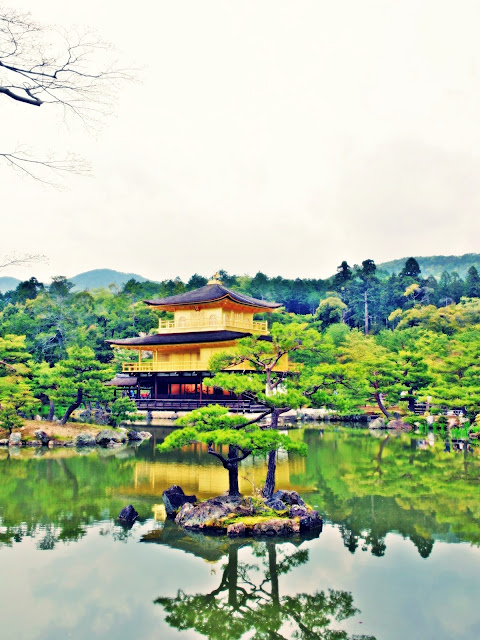
The site of Kinkaku-ji was originally a villa called Kitayama-dai,
owned by powerful statesman, Saionji Kintsune.
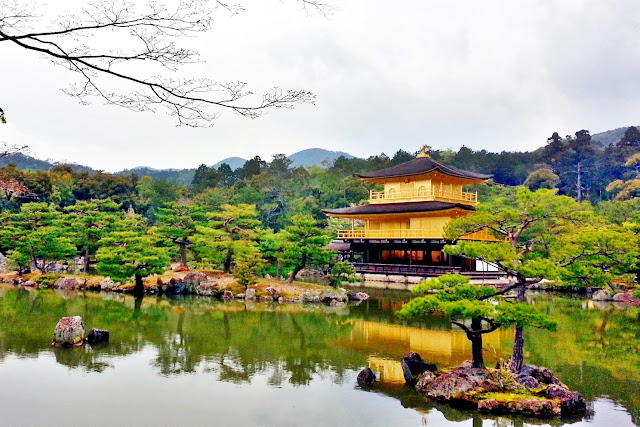
Kinkaku-ji's history dates to 1397, when the villa was purchased from the Saionji family
by Shogun Ashikaga Yoshimitsu, and transformed into the Kinkaku-ji complex.
When Yoshimitsu died, the building was converted into a Zen temple
by his son, according to his wishes. (Wikipedia)
The version I heard from the tour guide was more complicated,
but I remembered that our guide said to show his filial piety,
his son who built this temple.
Pure gold leaf foil on lacquer covered the upper top two levels
of the pavilion boasts its grandeur majestic view.
of the pavilion boasts its grandeur majestic view.
It blends well with lush green background and big mirror pond (鏡湖池 = Kyōko-chi), which designed to harmony between heaven and earth.

The gold color is believed to purify any negative thoughts and feelings towards death.

Kinkakuji was built to echo the extravagant Kitayama culture that
developed in
the wealthy aristocratic circles of Kyoto during
Yoshimitsu's times.
Each floor represents a different style of
architecture.
The building was an important model for Ginkaku-ji
(Silver Pavilion Temple) and Shōkoku-ji in Kyoto.
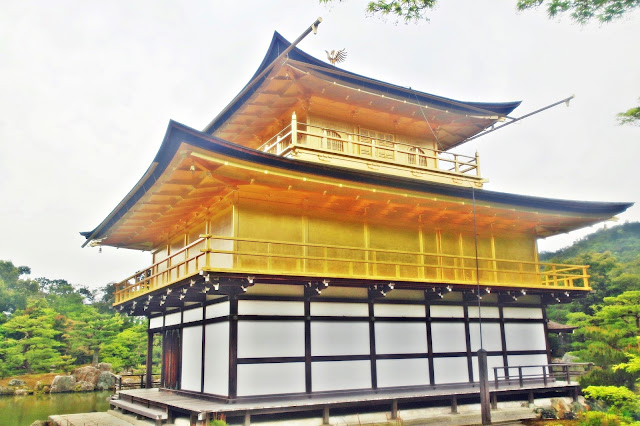
The first floor is built in the Shinden style used for palace buildings during
the Heian Period, with its natural wood pillars and white plaster walls
contrasts yet complements the gilded upper stories of the pavilion.

The first floor pavilion is called The Chamber of Dharma Waters,
which functions as Shariden, housing relics of the Buddha (Buddha's Ashes).
You can only view the statues from across the pond from the front windows,
because it is not allowed to enter the pavilion.
The second floor built in the Bukke style used in samurai residences.
This Buddha Hall (Butsuden) is called Tower of Sound Waves.
Inside seated Bodhisattva Kannon (Guānyīn) and
guarded by Shitenno (Four Heavenly Kings).

The uppermost third floor built in Chinese Zen style with cusped windows and ornaments.
Appropriately, it houses an Amida triad and twenty-five Bodhisattvas.
A shinning golden phoenix capped on top of the shingled roof. Overall, Kinkaku is representative of Muromachi-period architecture.

Rear view of Kinkaku-ji Golden Pavilion with Tsuridono (fishing deck).
Kinkakuji implemented the idea of borrowed scenery that integrates the outside and the inside, creating an extension of the views surrounding the pavilion and connecting it with the outside world.

From Golden pavilion, we walked pass by this Living quarters (Hojo)
of the former head priest, but it's also not open to public.

This Hojo is famous for the painted sliding doors (Fusuma).

Pretty interesting 600 years old pine tree... it looks like a sailing ship.
This tree gives the impression of sailing towards the Buddhist Pure Land. Though the temple has been burnt numerous times by war and by arson by a monk in 1950, this tree has survived all the fire disasters.

Behind the pavilion, there's another small pond called Anmintaku
where White Snake Mound located.
It said that Ashikaga Yoshimitsu had
many mistresses. One of them was deeply jealous of
the others, and threw herself into the pond and became white snake. Yoshimitsu built the stone pagoda to console her soul.

Hakujanotsuka (Stone Pagoda in memory of White Snake).
People tossing coins at the statues for good luck.
Then the guide brought us to temple's garden Kaiyūshikiteien. This strolling garden is designed to be a Buddhist
paradise based on the Western Pure Land of Amida Nyorai (Amitābha
Buddha) and with each step you feel more tranquil.

The Golden Pavilion is set in a magnificent Japanese strolling garden.

'Toryumon' The Dragon Waterfall.

This waterfall is designed to look like a carp fish
swimming upstream against the fiercely waterfall.
According to Chinese legend, any fish who can swim up a waterfall will turn into a Dragon. So this waterfall literally means Gateway to success, which convey the message that people who
overcome challenges or great difficulties will be successful.
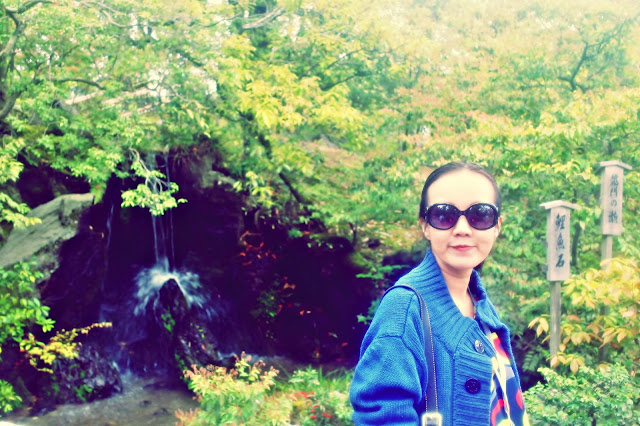
Toryumon also symbolized Ashikaga Yoshimitsu's successful life.
Yoshimitsu became a Shogun at 11. At that point of time when the Northern
and Southern Japanese dynasties were fighting. He managed to unify the
nation and restore relationships with Ming Dynasty at the age of 46. His life did seem like this carp fish swimming
against the waterfall!

Silver river stream.

Foot spa during Edo period?!

'Sekka-tei' classic tea house.
This tearoom was restored in 1997 after the original structure burnt down in 1950. It's the oldest building left of the one built during the Edo Period.

During the Edo Period, this detached teahouse was the entertainment building
for important
visitors. To mark its importance, there is a
celebrated pillar
made of nandina wood (heavenly bamboo).
It said that it's especially beautiful to see Golden Pavilion
from Sekka-tei cottage in the late afternoon sun.
Therefore, it's named Sekkatei (Place of Evening Beauty).

Walked down the hill, you'll see crowds in front of this small shrine, Fudō-do.
The shrine main image is a stone statue of Buddhist deity Fudo-myo-o (Acala, one of the Five Buddhist Wisdom Kings and Protector of Buddhism).

The statue was made by Kobo-Daishi, the founder of the Shingon sect in the 9th century.
Open door rituals are held on Setsubun on 3 February and 16 August. The statue is normally hidden from public view, but believed to have miraculous powers!

Instead of lining up to ring the bells to awake the deities,
we lighted candles and pray that our precious Xuan and Zhi
have wisdom and excel in their study
have wisdom and excel in their study

Hundreds of Ema (絵馬 wooden plaques) hanging on the stand next to the shrine.
You can buy the board and write your prayers or wishes and hang it here,
and the kami (spirits or gods) will receive and grant your wishes~^^
Amongst so many pictures like Japanese Maneki-neko Fortune Cat, Gods or Deities, my favorite Ema is Little iconoclastic Japanese Zen Buddhist monk 'Ikkyu' with Golden Pavilion.

Tourists busy tasting samples food, nuts, mochi from the teahouse and souvenir shops...

Love the vintage and rustic ambiance here...

People streaming out from Kinkaku-ji from this wooden gate.


The tour ended here, and we'd to walk out from this vast and stunning temple ground
and go to the next destination... Heian Shrine.
and go to the next destination... Heian Shrine.
Admission ticket to Kinkakuji, which is also function as talisman
to protect family and lucky charm to bring fortune and wealth.
According to our guide, Japanese believe black and white colors represent luck and fortune, unlike Chinese associated these colors with funeral / death. White symbolizes good luck and happiness, black color for good health and ward off evil spirits. This is also why Maneki-neko Fortune cat has tri-color beckoning good luck, wealth, prosperity.
Information:
Website: Kinkaku-ji (in Japanese)
Address: 1 Kinkakuji-cho, Kita-ku, Kyoto-shi, Kyoto
Opening hours: 9am-5pm
Admission: Adult (400 Yen), Student (300 Yen)
Directions: Kyoto Station by City Bus number 101 or 205 (40 minutes) or Karasuma Subway Line to Kitaoji Station (15 minutes)
Related Posts:

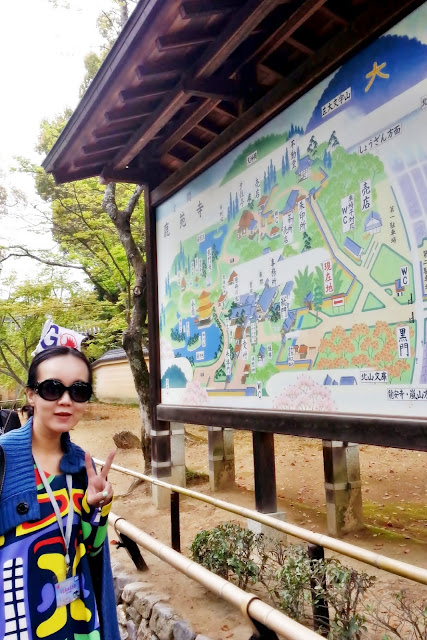






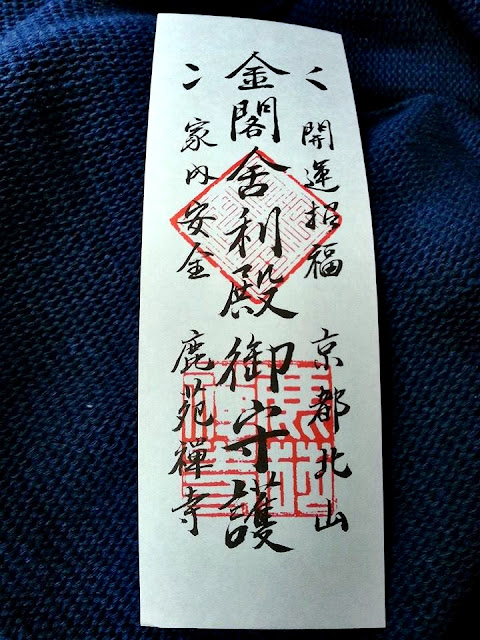


No comments:
Post a Comment